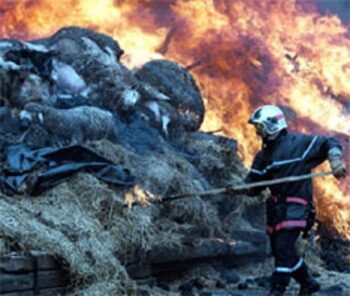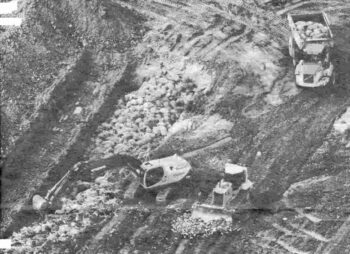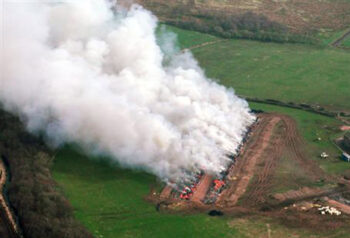Open-Air Incinerations
Fundamentals
Funeral fires on ceremonial pyres were common in Europe until the Christian Church banned this practice. In other parts of the world, where the Christian Church had little or no influence, the ritual burning of a deceased person remained quite common, most prominently in India. But even in Europe, burning dead bodies was practiced in times of mass deaths, such as epidemics or particularly during war time. The Second World War was no exception. In particular in various places where mass death occurred under German control, the resulting bodies are said to have been burned mostly on pyres, either on the flat ground or in pits and trenches.
The following table lists several German wartime camps plus the claimed crime scenes of the Einsatzgruppen, where a large number of bodies is said to have been burned on pyres, along with the point in time when these incinerations are said to have begun, if we follow the orthodox narrative:
| Location/Unit |
Claimed start of mass-grave exhumation and pyre cremation |
|---|---|
| Chełmno |
summer 1942 |
| Auschwitz |
late September 1942 |
| Sobibór |
October 1942 |
| Belzec |
January 1943 |
| Majdanek |
February 1943 |
| Treblinka |
April 1943 |
| Einsatzgruppen |
July 1943 |
These outdoor cremations are said to have been motivated in some cases by hygienic and sanitary concerns (groundwater pollution; Auschwitz) or by esthetic concerns (stench; Chełmno), but in most if not all cases primarily by an attempt to erase the traces of mass crimes, if we follow the orthodox narrative.
In all the cases listed, the bodies of mass casualties or mass murder were first buried in mass graves, but presumably on orders of Heinrich Himmler, they all had to be exhumed again and burned. However, no documental trace of such a Himmler order has ever been found. It is attested to only by witness claims of low credibility (such as that by Rudolf Höss). To the contrary, a letter written by Himmler on 20 November 1942 has been preserved which clearly specifies that the bodies of deceased Jews have to be either cremated or buried. Hence, still in late 1942 no Himmler order existed to exhume and cremate all buried bodies (see Mattogno 2022c, p. 450). Therefore, none of the exhumation and cremation actions started prior to this date can be based on a general Himmler order. If any such order has ever been issued, one would furthermore expect it to have been implemented everywhere more or less at the same time, but this is absolutely not what we see.
Technologies
The biggest challenge when trying to combust a body is to raise its temperature to a point where its combustible components can ignite. The biggest impediment for this is the natural water content, which is about ⅔ of the mass of a human body. Most of this water has to evaporate first before tissue temperature can be raised to a point where it will combust.
The biggest enemy of open-air incineration is heat loss of any fire due to convection and radiation. This can be counteracted by surrounding the fire with insulated, heat-reflecting floors, walls and a ceiling, and ideally by extracting the heat contained in the smoke gases and using it to heat up air/oxygen fed into the fire for combustion. This is ultimately what properly designed cremation furnaces do. However, there are multiple stages to reach this technological endpoint. Energetically speaking, the worst open-air incineration is one that is conducted on a plain flat surface. The more a fire is surrounded by walls, the more its heat gets preserved. Hence, an efficient pyre is located in a pit or trench rather than on the flat soil. The closer the walls are together, the better. Therefore, a narrow and long, rectangular trench is better than a square-shaped one of the same surface area.
Abundant experience with funeral pyres in India, scientifically evaluated experiences during various cattle epidemics – especially the major hoof-and-mouth epidemic among British livestock in 2001 – as well as a dedicated scientific study designed to determine the fuel requirements for the cremation of bodies on open-air pyres, have all led to some relatively reliable data, regarding:
- How much fuel is needed to cremate a body of a certain mass on open-air cremation pyres.
- Which is the best way of arranging open-air incineration pyres in case of mass cremations of hundreds or even thousands of bodies.
- What are the space and time requirements in such cases.
Structure

 Outdoor livestock carcass cremation in the UK in 2001, seen from the air. Pit, excavated soil, massive destruction of vegetation and topsoil around the pits – nothing of that kind can be seen on any of the air photos of Auschwitz.
Outdoor livestock carcass cremation in the UK in 2001, seen from the air. Pit, excavated soil, massive destruction of vegetation and topsoil around the pits – nothing of that kind can be seen on any of the air photos of Auschwitz. Outdoor livestock carcass cremation in the UK in 2001, seen from the air. The pyres which allegedly burned at Auschwitz, Belzec, Sobibór and Treblinka would have dwarfed fires like this and would have blanketed the entire area in smoke. Nothing of that kind can be seen on any of the air photos of Auschwitz.
Outdoor livestock carcass cremation in the UK in 2001, seen from the air. The pyres which allegedly burned at Auschwitz, Belzec, Sobibór and Treblinka would have dwarfed fires like this and would have blanketed the entire area in smoke. Nothing of that kind can be seen on any of the air photos of Auschwitz.According to this data, a single-row pyre up to 2.5 m wide is required, so that air can reach in from both sides, and the pyre can be built and later maintained from both sides (stoking, refueling etc.). Fuel is to be placed at the bottom, with the bodies to be incinerated at the top, so that heat and flames rising from the fuel get used optimally. The longer the distance from the edge to the center of the pyre, the worse it will be supplied with oxygen, thus burning more slowly and unevenly.
The total height of a pyre should not exceed some 2 m (about 6 feet), resulting in a layer of fuel at the bottom and few layers of human corpses on top. If stacked higher, it becomes increasingly difficult to build such a pyre without technical equipment. Furthermore, the risk that the pile topples over increases considerably, for instance if the pyre burns unevenly, or any frozen ground melts and thus gives way unevenly.
If not wearing fireproof clothing, a safe distance of some 50 m minimum must be kept from a burning fire (similar to house or forest fires). If another pyre is operating next to a burning one, that distance needs to be increased to allow maneuvering room.
Time and Effort
Single-body cremation pyres take some 6-7 hours to burn down, with an additional 6-7 hours for the hot embers to fully consume the body. Ideally, bodies should not lie next to each other on a pyre, but should be spaced apart, to allow flames and heat to rise between them. Bodies are heat sinks during most of the cremation process. Forming a large layer of bodies interferes with complete combustion. The resulting low fire temperatures beneath the bodies lead to prolonged cremation times and increased fuel requirements.
Under no circumstances should bodies be stacked, since the upper layers of bodies start burning only once the lower layers have been almost completely consumed. Hence, the burning time of any stacked pyre increases proportionately with the number of layers.
Closely packed large-scale livestock pyres usually take at least one day to burn down. However, embers in the ashes keep glowing for up to a week or two. Hence, if the ashes are to be further processed (crushed), then it is necessary to wait for one to two weeks for everything to completely cool down. (Dousing with water would speed up cooling, but would make the frequently claimed ash-processing with sieves impossible.)
For example, the incineration of 800 British sheep required some 100 soldiers plus trucks and other equipment to move fuel and carcasses (such as backhoes or excavators). Without such equipment, considerably more men would be needed.
Once the pyres are lit, approaching them is possible only with protective clothes as worn by fire fighters.
Environmental Impact
Large outdoor cremation operations have a considerable impact on the environment. Two effects are of concern in the present context (see the illustrations):
- Moving topsoil to accommodate the pyres, transporting and arranging carcasses and fuel, as well as maintaining the fire and disposing of the cremation leftovers tear up the soil in large areas around the pyres.
- The fires themselves create huge smoke plumes which, depending on prevailing winds, can cover large areas of the sky.
Fuel
Data vary on the fuel necessary to cremate a corpse with the equivalent mass of an average human body. In terms of wood, most values given range from 100 to 200 kg of dry (seasoned) wood. The type of wood is also a factor, as hard woods like oak and maple have higher energy contents than soft woods, such as pine or spruce. Thus, results vary depending on the different pyre layouts and the different kinds of fuels used.
An Australian study of pyre cremations, using dry pine wood, found that one needed five times as much firewood as organic matter (by mass) to achieve (almost) complete “thermal degradation” only if the carcass was small and wood was added continuously. With a large carcass and stacked firewood (without addition), the wood mass requirement grows to nine times that of the carcass mass (Yermán et al.).
If freshly cut wood is used instead, the amount required easily doubles, due to the high water content of fresh wood. For the German camps, assuming 250 kg of fresh (green) wood per body is thus a very low, very conservative estimate. A more realistic value is probably twice as high: perhaps 500 kg per body.
Self-immolating bodies are not part of the scientific literature, as none have ever been discovered during single-body or large-scale cremations. In fact, after a series of experiments, Yermán et al. bluntly concluded: “Self-sustained burning of animal carcasses in an open pyre configuration is not possible.”
A 50-year-old spruce forest usually yields some 500 solid cubic meters of wood per hectare (100 m × 100 m, a little more than two American football fields). This amounts to about 450 metric tons of wood. Hence, a square kilometer of such a forest contains some 45,000 metric tons of wood, and a square mile some 116,550 metric tons of wood.
An average prisoner is rated at being able to cut some 0.63 metric tons of fresh wood per workday. This value can be used to calculate, how many inmate lumberjacks it takes to cut a certain amount of wood within a given period of time. The entry on lumberjacks gives an overview of the firewood that would have been needed to burn the number of corpses alleged by witnesses, or by the orthodox narrative for various claimed Holocaust crime scenes. As an example, the next section discusses some claims made about outdoor cremations at the Auschwitz Camp.
(For details on open-air incinerations, see Mattogno 2016b, esp. pp. 60-63, 128-133; Graf/Kues/Mattogno 2020, pp. 138-157; Mattogno/Kues/Graf 2015, pp. 1226-1328; Yermán et al.)
Holocaust Scenarios
Based upon the data resulting from large-scale animal cremations outdoors, it can be deduced that an optimally designed pyre using dry wood can be loaded with some 8 to 10 human corpses per running meter, or 4 to 5 bodies when using fresh wood. For instance, a pyre 20 m long and 2 m wide using dry wood could accommodate some 200 corpses (see Mattogno 2016b, pp. 134f.).
Former Auschwitz inmate Stanisław Jankowski, who gave 20 m × 2 m as the dimensions of the pyres he claims to have seen, insisted, however, that these pyres accommodated 2,000 bodies, which means that they would have been not 2 meters, but 20 meters high (when using dry wood) – a physical impossibility. When using fresh wood, the wood alone would have stacked up to almost 20 meters. The pit data claimed by former Auschwitz inmate Joshuah Rosenblum are similarly detached from reality. In addition, he and other Auschwitz inmates described the pyres as having been 5, 6, 8, 10, even 15 meters wide, which would have made it difficult to build them, impossible to maintain their centers, and inefficient to burn (see the table).
|
Witness |
Pits |
Length |
Width |
Depth |
Location |
Bodies per pit |
Time |
Wood* |
Height† |
|---|---|---|---|---|---|---|---|---|---|
|
3 |
12 m |
6 m |
1.5 m |
near Crematorium V |
333 |
1 hour |
83 t |
1.8 m |
|
|
1 |
– |
– |
4 m |
near “Bunker 2” |
– |
– |
|||
|
5 |
25 m |
6 m |
3 m |
near Crematorium V |
1,000 |
1 day |
250 t |
2.6 m |
|
|
2 |
20 m |
2 m |
2 m |
near Crematorium V |
2,000 |
– |
500 t |
19.4 m |
|
|
– |
30-35 m |
15 m |
– |
near Crematorium V |
1,500-1,800 |
1-2 days |
375-450 t |
1.1-1.3 m |
|
|
5 |
40-50 m |
8 m |
2 m |
near Crematorium V |
1,200 |
5-6 hours |
300 t |
1.2 m |
|
|
4 |
– |
– |
– |
near “Bunker 2” |
– |
– |
|||
|
2 |
50 m |
6 m |
3 m |
near “Bunker 2″ |
2,500 |
1 day |
625 t |
3.2 m |
|
|
2 |
30 m |
6-10 m |
– |
near “Bunker 2” |
– |
– |
|||
|
– |
10 m |
5 m |
2 m |
unspecified |
2,000 |
2-3 hours |
500 t |
15.5 m |
|
|
– |
30 m |
15 m |
– |
unspecified |
– |
– |
|||
|
4-5 |
– |
– |
– |
near Crematorium V |
> 400 |
2 days |
100 t |
||
|
1 |
– |
– |
– |
near “Bunker 2” |
– |
– |
|||
| Source: Mattogno 2016b, p. 28. * Fresh wood required, at 250 kg per body. † Stacking height just for the fresh wood, at 0.9 kg/m³, and a packing density of 1.4., calculated for the largest pit area indicated. ‡ Together with Czesław Mordowicz. | |||||||||
This is even truer for the alleged depth of the pits in which these pyres were allegedly placed: 1.5 to 4 meters, depending on the witness. With the groundwater standing close to the surface at Birkenau, any pit deeper than a meter was in acute danger of filling up with water, thus preventing any fire.
But independent of the groundwater level, building a pyre in a wide pit wouldn’t have led to much of a gain in efficiency, but it certainly would have complicated the building, maintenance and clearing of such pyres, hence it would have made no sense at all.
The time allegedly required for building, burning and clearing out a pyre is commonly given as several hours, a day or at most two days, with the ashes being sifted through large sieves, in search of dental gold or silver or large unburned wood pieces and body parts, to be ground down or further burned. An extreme outlier in this regard is Charles Bendel, who gave a ludicrously short time of just one hour to process such a pyre.
Considering that it would have taken a week or more for a large pyre to cool down to the point when its ashes could be handled this way, such witness claims further demonstrate that they originate from fantasy rather than reality. (For more on ashes, see Mattogno 2016b, pp. 63-65.)
For more details on open-air incinerations at the various claimed Holocaust crime scenes, see the links in the initial table of this entry, as well as the entry on lumberjacks.

You need to be a registered user, logged into your account, and your comment must comply with our Acceptable Use Policy, for your comment to get published. (Click here to log in or register.)